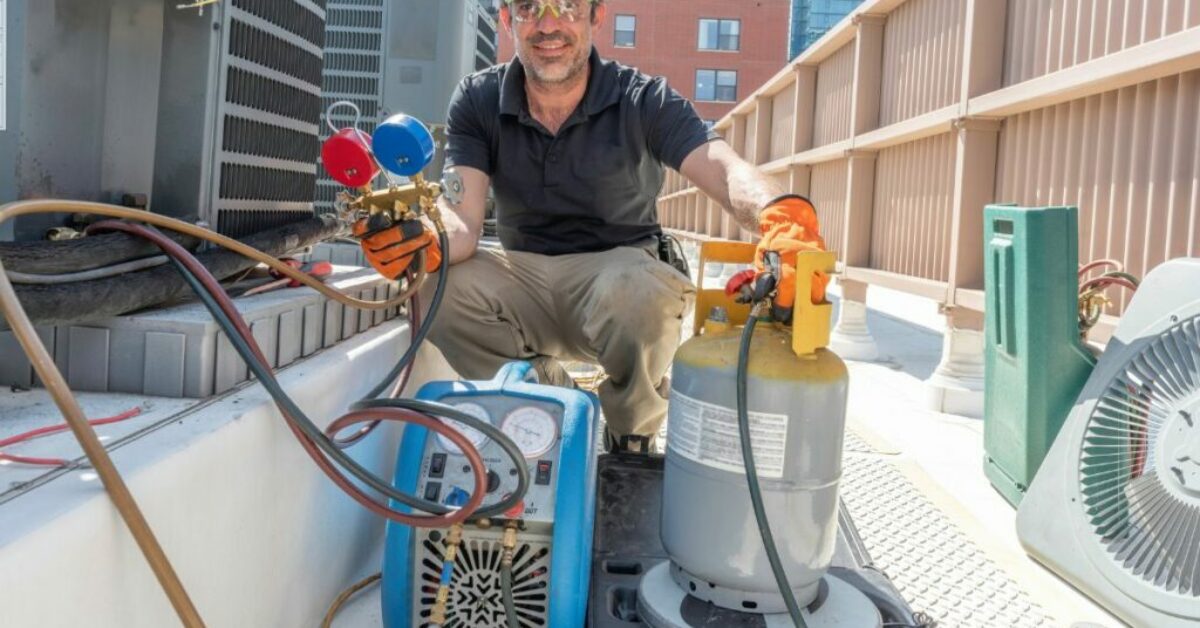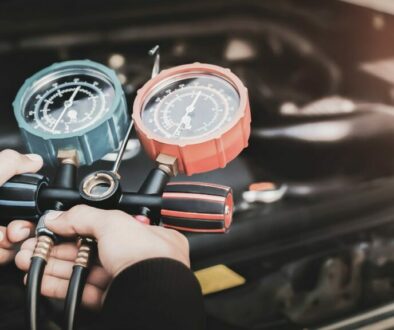EPA Section 608 Technician Certification
If you’re looking to pursue a career as a technician in the HVAC/Refrigeration industry, then obtaining an EPA Section 608 Technician Certification should be a top priority for you. In this certification, you’ll acquire the knowledge and skills necessary to handle refrigerants safely, understand the regulations surrounding their use, and ultimately protect the environment.
Understanding EPA Section 608
EPA Section 608 is a vital program that regulates the handling of refrigerants to safeguard the environment from their potentially harmful effects. Refrigerants are used in HVAC/R equipment and systems, and their release into the atmosphere can cause significant damage to the ozone layer and contribute to climate change. The program applies to anyone who manufactures, installs, or repairs HVAC/R equipment and systems.
What is EPA Section 608?
EPA Section 608 is a critical program under the Clean Air Act that regulates the handling of refrigerants to prevent their release into the environment. The program requires anyone who works on HVAC/R equipment containing refrigerants to obtain a certification. The certification tests one’s knowledge on topics such as the proper handling, recovery, and disposal of refrigerants. It helps ensure that technicians handle refrigerants safely and minimize the risk of emissions.
Refrigerants are hazardous substances that can cause significant harm to the environment and human health if not handled correctly. The EPA Section 608 program is designed to protect the public and the environment from these harmful effects.
Importance of EPA Section 608 Certification
Obtaining EPA Section 608 certification is not only a legal requirement for HVAC/R technicians but also a mark of professionalism and environmental responsibility. The certification demonstrates that you have the knowledge and skills to handle refrigerants safely, minimize emissions, and protect the environment. Employers also value this certification, as it demonstrates your commitment to safety and compliance with industry regulations. Having the certification can also open up career advancement and higher-paying job opportunities.
As an HVAC/R technician, it is your responsibility to ensure that refrigerants are handled safely and disposed of properly to protect the environment and public health. EPA Section 608 certification is a crucial step towards achieving this goal.
Regulations and Requirements
EPA Section 608 includes various regulations that technicians must follow during the handling of refrigerants. One of the primary requirements is obtaining the appropriate certification to work with specific types of refrigerants. The certification levels include Type I, Type II, Type III, and Universal. Technicians must also comply with proper refrigerant handling techniques and disposal procedures and provide adequate record-keeping of any refrigerant-related activity.
Failure to comply with EPA Section 608 regulations can result in penalties and fines. It is essential to stay up-to-date with the latest regulations and requirements to ensure compliance and protect the environment.
EPA Section 608 is a crucial program that regulates the handling of refrigerants to protect the environment and public health. Obtaining EPA Section 608 certification is a legal requirement for HVAC/R technicians and demonstrates professionalism, environmental responsibility, and commitment to safety and compliance with industry regulations.
Types of EPA Section 608 Certifications
When it comes to handling refrigerants, technicians must have the appropriate EPA Section 608 certification. The certification level required depends on the type of equipment or system they will be working with. There are four types of certifications available, each with its own set of requirements and limitations.
Type I Certification
Type I certification is the entry-level certification necessary for working with small appliances that contain five pounds or fewer of refrigerant. These appliances include window air conditioning units, refrigerators, and freezers commonly found in households. Technicians with this certification can recover refrigerant from these small appliances, but they cannot repair or install any equipment. The Type I certification exam covers the proper handling of refrigerants, recovery techniques, and safety procedures.
Type II Certification
A Type II certification allows technicians to work with medium- to high-pressure appliances like residential air conditioning and heat pumps. These appliances contain more than five pounds but less than 50 pounds of refrigerant. Technicians with this certification can also recover and recycle refrigerants from these appliances. In addition to the topics covered in the Type I exam, the Type II certification exam covers the use of recovery and recycling equipment, leak detection, and system evacuation.
Type III Certification
Technicians with a Type III certification can work with low-pressure appliances. These include chillers and refrigeration systems used in supermarkets or other large-scale businesses. These appliances contain more than 50 pounds of refrigerant. With this certification, technicians can recover refrigerant and do system repair. The Type III certification exam covers the use of recovery equipment, leak detection, evacuation, and charging techniques for low-pressure systems.
Universal Certification
The Universal certification is a combination of Type I, Type II, and Type III certifications. Technicians with this certification can work with all types of equipment, appliances, and systems. This certification is recommended for anyone who wants a wide range of employment opportunities in the HVAC/R industry. The Universal certification exam covers all the topics included in the Type I, Type II, and Type III exams.
It’s important for technicians to obtain the appropriate certification level before working with refrigerants. Failure to do so can result in fines and legal consequences. In addition, proper handling of refrigerants is crucial for protecting the environment and public health. By obtaining the necessary EPA Section 608 certification, technicians can ensure they are qualified to handle refrigerants safely and responsibly.
Preparing for the EPA Section 608 Exam
As an HVAC technician, obtaining the EPA Section 608 certification is crucial to your career advancement. This certification demonstrates your knowledge and expertise in handling refrigerants and complying with environmental regulations. The exam consists of 80 multiple-choice questions, and the passing score is 70%. Here are some tips to help you prepare for the exam.
Study Materials and Resources
There are several study materials and resources available to help technicians prepare for the EPA Section 608 certification exam. These resources include online courses, study guides, practice exams, and textbooks. It’s essential to choose study materials that cover all the necessary exam topics and align with the certification level you’re seeking.
Online courses are an excellent option for those who prefer a self-paced learning environment. These courses often include interactive modules, quizzes, and simulations to help you learn and retain the material. Study guides and textbooks are also helpful resources, as they provide a comprehensive overview of the exam topics and may include practice questions.
Key Topics to Focus On
Technicians should focus their study efforts on topics such as refrigerant recovery techniques, leak detection, regulations, and system repair and installation. They should also understand the health and safety implications of handling refrigerants and the environmental impact associated with refrigerant emissions.
Refrigerant recovery techniques involve the proper handling and disposal of refrigerants to prevent environmental damage. Technicians should be familiar with the different recovery methods and the equipment required for each method. Leak detection is another critical topic, as refrigerant leaks can lead to system failure and environmental harm. Technicians should know how to identify and repair leaks using various techniques.
Regulations are a significant part of the EPA Section 608 exam. Technicians should understand the regulations governing the use and disposal of refrigerants, as well as the penalties for non-compliance. System repair and installation are also essential topics, as technicians must know how to install and repair HVAC systems safely and efficiently.
Tips for Successful Exam Preparation
The key to successful exam preparation is to start early and create a study plan that works for you. Allocate sufficient time for each topic and take frequent breaks to avoid burnout. Additionally, ensure that you’re familiar with the exam format and structure and practice answering sample questions to boost your confidence and reduce exam anxiety.
Another helpful tip is to join study groups or find a study partner. Studying with others can help you stay motivated and accountable, and you can learn from each other’s strengths and weaknesses. Finally, make sure to get plenty of rest and eat a healthy diet in the days leading up to the exam. A healthy body and mind will help you perform your best on exam day.
Taking the EPA Section 608 Exam
Exam Format and Structure
The EPA Section 608 certification exam is an important requirement for technicians who work with refrigeration systems and equipment. This exam is designed to test technicians’ knowledge of refrigerant recovery, refrigeration systems, and equipment installation and repair. The exam consists of 80 multiple-choice questions that must be answered in two hours. Technicians must achieve a passing score of 70% or higher to obtain the certification.
The exam is divided into four sections, each covering different topics related to refrigeration systems and equipment. The first section covers the core topics related to refrigeration systems, such as the properties of refrigerants, refrigeration cycle, and refrigerant recovery. The second section covers the different types of refrigeration systems, including air conditioning, refrigeration, and heat pumps. The third section covers equipment installation and repair, including troubleshooting, leak detection, and refrigerant charging. The fourth and final section covers environmental regulations related to refrigeration systems, such as the Clean Air Act and the Montreal Protocol.
To prepare for the exam, technicians should study the EPA Section 608 Study Guide, which provides detailed information on the topics covered in the exam. They can also take practice exams to get a sense of the exam format and structure.
Registration and Scheduling
Registration and scheduling for the EPA Section 608 exam can be done online or through an approved testing center. Technicians should ensure that they register for the appropriate exam level and familiarize themselves with the exam location and time. They should also arrive at least 15 minutes before the exam start time and bring government-issued identification.
It’s important to note that there are four different types of EPA Section 608 certifications available, each with its own set of requirements. Technicians should ensure that they are registering for the correct certification level based on their job responsibilities and the type of equipment they work with.
Technicians who work with small appliances, such as refrigerators and window air conditioners, are required to obtain Type I certification. Those who work with high-pressure appliances, such as commercial refrigeration systems, must obtain Type II certification. Technicians who work with low-pressure appliances, such as chillers, must obtain Type III certification. Finally, technicians who work with all types of appliances must obtain Universal certification.
What to Expect on Exam Day
On exam day, technicians should arrive early to give themselves enough time to check-in and get familiar with the testing area. They’ll be provided with scratch paper and pencils to work with during the exam, but no other materials are permitted. Technicians should also ensure they understand the exam instructions and format before starting the exam.
During the exam, technicians should take their time and read each question carefully before answering. They should also ensure that they are answering the question that is being asked, as some questions may have multiple correct answers. Technicians should also pay attention to the time remaining and pace themselves accordingly.
After completing the exam, technicians will receive their score immediately. If they pass, they will receive their certification, which is valid for five years. If they do not pass, they will have the opportunity to retake the exam after a waiting period of 30 days.
Obtaining EPA Section 608 certification is an important step for technicians who work with refrigeration systems and equipment. By familiarizing themselves with the exam format and structure, registering for the appropriate certification level, and preparing for the exam, technicians can increase their chances of passing and obtaining their certification.
Maintaining and Renewing Your Certification
As an HVAC/R technician, obtaining your EPA Section 608 certification is a crucial step in your career. It allows you to work with refrigerants and ensures that you have the knowledge and skills necessary to handle these substances safely. However, obtaining your certification is only the first step. To maintain and renew your certification, there are specific requirements you must meet.
Continuing Education Requirements
One of the most critical requirements for maintaining and renewing your EPA Section 608 certification is completing continuing education (CE) courses. These courses are designed to keep you up-to-date with the latest industry standards, regulations, and best practices. The number of CE hours you need to complete varies depending on the certification level you hold. For example, Type I and Type II technicians need to complete 3 hours of CE, while Type III technicians need to complete 4 hours of CE. Universal technicians need to complete 5 hours of CE.
CE courses must be approved by the EPA and cover specific topics related to refrigerant handling, leak detection, and system repair. These courses can be taken in-person or online, and many organizations offer them throughout the year. It’s essential to keep track of the CE courses you’ve completed and ensure that they meet the EPA’s requirements.
Staying Updated on Industry Changes
The HVAC/R industry is continually evolving, and it’s crucial for technicians to keep up with industry changes and updates. EPA regulations and requirements may change, and technicians must stay informed about these changes to avoid violations and penalties. One way to stay informed is to join industry associations and attend conferences and trade shows. These events provide an opportunity to network with other professionals and learn about the latest industry trends and best practices.
Another way to stay informed is to read industry publications and newsletters. These resources provide valuable information about new products, technologies, and regulations. By staying informed, you can ensure that you’re providing the best possible service to your customers and maintaining your certification.
Renewal Process and Timeline
Technicians must renew their EPA Section 608 certification every three years. The renewal process involves completing the necessary CE hours and submitting the renewal application and fee. Technicians should ensure they renew their certification before the expiration date to avoid any lapse in certification. If your certification does lapse, you’ll need to retake the exam to regain your certification.
Maintaining and renewing your EPA Section 608 certification is essential for HVAC/R technicians. By completing the necessary CE courses, staying informed about industry changes, and renewing your certification on time, you can ensure that you’re providing the best possible service to your customers and maintaining your certification.
Career Opportunities for EPA Section 608 Certified Technicians
As the world becomes more conscious of the impact of climate change, the need for skilled technicians in the HVAC/R industry is increasing. EPA Section 608 certification can open up various job opportunities for technicians in the industry. Technicians with this certification can work as refrigeration technicians, HVAC installers, equipment repair technicians, and maintenance workers.
Refrigeration technicians are responsible for installing, maintaining, and repairing refrigeration systems in various industries such as food processing, pharmaceuticals, and transportation. HVAC installers, on the other hand, install heating, ventilation, and air conditioning systems in homes, offices, and other buildings.
Equipment repair technicians troubleshoot and repair malfunctioning HVAC/R equipment and systems. They diagnose problems, replace parts, and ensure that the equipment is functioning efficiently. Maintenance workers, on the other hand, perform routine maintenance tasks such as cleaning and inspecting equipment and systems to prevent breakdowns and ensure optimal performance.
Industries and Sectors
EPA Section 608 certified technicians can work in several industries and sectors, including commercial, industrial, and residential. They can work for HVAC/R contractors, government agencies, manufacturing companies, and independent businesses. In the commercial sector, they can work in hospitals, schools, and shopping malls. In the industrial sector, they can work in factories, warehouses, and power plants. In the residential sector, they can work in homes, apartments, and condominiums.
Obtaining this certification enhances your employability in the HVAC/R industry and increases your earning potential. With the increasing demand for skilled technicians, job opportunities for EPA Section 608 certified technicians are expected to grow in the coming years.
Salary and Growth Potential
According to the Bureau of Labor Statistics, the median annual wage for HVAC/R technicians was $50,590 as of May 2020. However, technicians with EPA Section 608 certification typically earn higher salaries due to their specialized skills and knowledge. The salary range for EPA Section 608 certified technicians varies depending on the job role, industry, and location. For example, refrigeration technicians working in the food processing industry may earn more than those working in the transportation industry.
As the demand for HVAC/R technicians continues to grow, obtaining this certification can increase your growth potential and job security in the industry. With the increasing emphasis on energy efficiency and sustainability, the need for skilled technicians who can install and maintain energy-efficient HVAC/R systems is expected to rise.
Obtaining EPA Section 608 certification is an essential step for technicians in the HVAC/R industry. It demonstrates a commitment to safety, environmental awareness, and professionalism. With the different certification levels available, technicians can specialize in specific areas and increase their job opportunities and earning potential. It’s crucial for technicians to maintain their certification by completing the required CE hours and staying informed about industry changes to avoid any violations or penalties.




